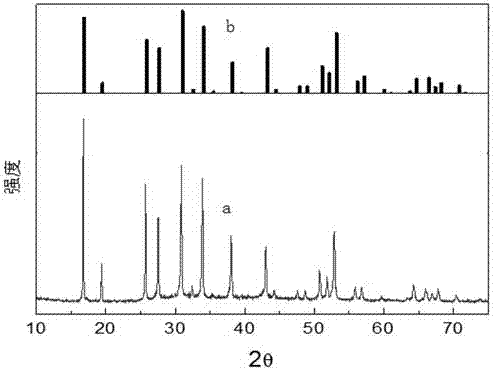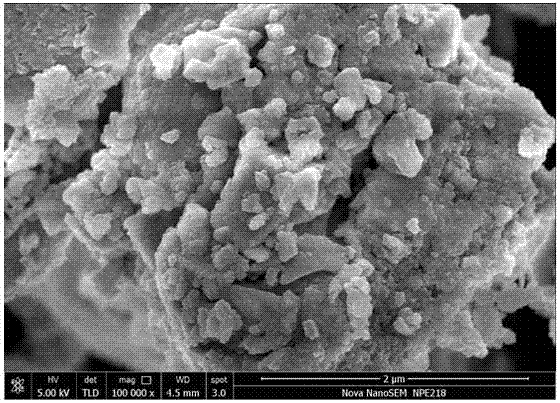A tantalum-doped cubic garnet structure li 7 la 3 zr 2‑x ta x o 12 Materials and their preparation methods
A garnet and cubic technology, applied in the field of lithium-ion battery electrolyte materials, can solve problems such as cost increase, Li element loss, energy consumption, etc., and achieve the effects of energy saving, good crystal form, and reduced content requirements
- Summary
- Abstract
- Description
- Claims
- Application Information
AI Technical Summary
Problems solved by technology
Method used
Image
Examples
Embodiment 1
[0026] (1) Weigh lanthanum zirconate, lanthanum oxide, lithium acetate and lithium tantalate, the molar ratio of lanthanum zirconate to lanthanum oxide is 7:5, the molar ratio of lanthanum zirconate to lithium acetate is 1:8, lanthanum zirconate The molar ratio with lithium tantalate is 7:2 to meet the requirements of Li 7 La 3 Zr 1.75 Ta 0.25 o 12 The molar ratio of each element in the molecular formula. The above materials were successively placed in a glass beaker, and complexing agent was added and stirred for 6 hours.
[0027] (2) After mixing evenly, the stirrer starts to heat, gradually raise the temperature to 80°C and keep it warm until the excess water is removed, and finally a paste appears, which is the precursor of high-temperature solid-phase treatment.
[0028] (3) Preheat the precursor in a tube furnace at 400°C for 3 hours to remove cyclodextrin and a small amount of residual water, take out the product and grind it evenly with an agate mortar, then bake ...
Embodiment 2
[0033] (1) Weigh lanthanum zirconate, lanthanum oxide, lithium acetate and lithium tantalate, the molar ratio of lanthanum zirconate and lanthanum hydroxide is 7:10, the molar ratio of lanthanum zirconate and lithium acetate is 1:8, zirconate The molar ratio of lanthanum to lithium tantalate is 7:2 to meet the Li 7 La 3 Zr 1.75 Ta 0.25 o 12 molar ratio. The above materials were successively placed in a glass beaker and complexing agent was added and stirred for 4 hours.
[0034] (2) After mixing evenly, the stirrer starts to heat, gradually raise the temperature to 80°C and keep it warm until the excess water is removed, and finally a paste appears, which is the precursor of high-temperature solid-phase treatment.
[0035] (3) Preheat the precursor in a tube furnace at 400°C for 3 hours to remove cyclodextrin and a small amount of residual water, take out the product and grind it evenly with an agate mortar, then bake it in a tube furnace at 900°C for 5 hours , get Li 7...
Embodiment 3
[0038] (1) Weigh lanthanum zirconate, lanthanum oxide, lithium nitrate and lithium tantalate, the molar ratio of lanthanum zirconate and lanthanum oxide is 7:5, the molar ratio of lanthanum zirconate and lithium nitrate is 1:8, lanthanum zirconate The molar ratio with lithium tantalate is 7:2 to meet the requirements of Li 7 La 3 Zr 1.75 Ta 0.25 o 12 molar ratio. The above materials were successively placed in a glass beaker and complexing agent was added and stirred for 4 hours.
[0039] (2) After mixing evenly, the stirrer starts to heat, gradually raise the temperature to 80°C and keep it warm until the excess water is removed, and finally a paste appears, which is the precursor of high-temperature solid-phase treatment.
[0040] (3) Preheat the precursor in a tube furnace at 400°C for 4 hours to remove cyclodextrin and a small amount of residual water, take out the product and grind it evenly with an agate mortar, then bake it in a tube furnace at 900°C for 1.5 hours ...
PUM
| Property | Measurement | Unit |
|---|---|---|
| electrical conductivity | aaaaa | aaaaa |
Abstract
Description
Claims
Application Information
 Login to View More
Login to View More - R&D
- Intellectual Property
- Life Sciences
- Materials
- Tech Scout
- Unparalleled Data Quality
- Higher Quality Content
- 60% Fewer Hallucinations
Browse by: Latest US Patents, China's latest patents, Technical Efficacy Thesaurus, Application Domain, Technology Topic, Popular Technical Reports.
© 2025 PatSnap. All rights reserved.Legal|Privacy policy|Modern Slavery Act Transparency Statement|Sitemap|About US| Contact US: help@patsnap.com


